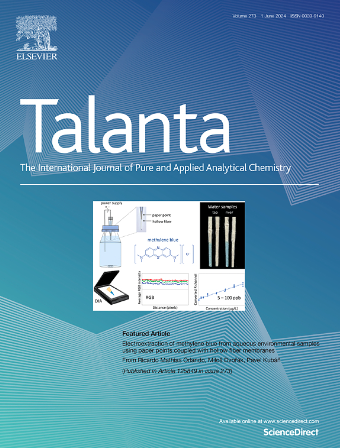The MoS2/ZnO p-n heterostructure arrays for ultrasensitive ppb-level self-supporting NO2 gas sensors under UV irradiation
IF 5.6
1区 化学
Q1 CHEMISTRY, ANALYTICAL
引用次数: 0
Abstract
Light irradiation has emerged as a promising strategy to promote low operating temperatures of metal oxides semiconductors gas sensors. Traditional sensors have high operating temperatures, low electron-hole separation, and low gas response. Therefore, MoS2/ZnO heterostructure arrays were synthesized based on ITO conductive glass by hydrothermal and calcination methods as self-supporting sensors. Self-supporting sensors overcome limitations of traditional sensor fabrication. The successful preparation of self-supporting sensors is confirmed by a series of tests. The response of the gas sensor is determined as Rg/Ra or Ra/Rg (Ra and Rg indicate the resistance of the sensor in air and test gases). Regarding the gas-sensing performance, MoS2/ZnO-20 self-supporting sensor under UV irradiation exhibits ultrahigh response of 1088.43 to 10 ppm NO2 at 80 °C, which is 47 times higher than pure ZnO (23.21). Furthermore, operating temperature under UV irradiation is reduced by up to 60 °C. Additionally, MoS2/ZnO-20 self-supporting sensor demonstrates rapid response/recovery time (100/3 s), high selectivity, and ultralow theoretical detection limit (10.37 ppb). The p-n charge separation mechanism is employed to elucidate sensing mechanism of MoS2/ZnO self-supporting sensor for NO2 under UV irradiation. The efficient photogenerated carrier separation efficiency, large surface area, and the presence of multiple heterostructures are responsible for the high gas-sensing performance of MoS2/ZnO self-supporting sensor. Therefore, this study offers insights into the fabrication of ultrasensitive self-supporting sensors for low-temperature detection of NO2 under light irradiation.

紫外辐射下用于超灵敏ppb级自支撑NO2气体传感器的MoS2/ZnO p-n异质结构阵列
光照射已成为一种很有前途的策略,以促进金属氧化物半导体气体传感器的低工作温度。传统传感器工作温度高,电子空穴分离低,气体响应低。为此,采用水热法和煅烧法在ITO导电玻璃上合成MoS2/ZnO异质结构阵列作为自支撑传感器。自支撑式传感器克服了传统传感器制造的局限性。通过一系列试验,证实了自支撑式传感器的成功制备。气体传感器的响应确定为Rg/Ra或Ra/Rg (Ra和Rg表示传感器在空气和测试气体中的电阻)。在气敏性能方面,MoS2/ZnO-20自支撑型传感器在80℃下对1088.43 ppm NO2表现出超高的响应,是纯ZnO的47倍(23.21)。此外,紫外线照射下的操作温度降低了60°C。此外,MoS2/ZnO-20自支撑传感器具有快速响应/恢复时间(100/3 s),高选择性和超低理论检测限(10.37 ppb)的特点。利用p-n电荷分离机理,阐明了紫外光照射下MoS2/ZnO自支撑传感器对NO2的传感机理。高效的光生载流子分离效率、大的比表面积和多种异质结构的存在是MoS2/ZnO自支撑传感器具有高气敏性能的原因。因此,本研究为光照射下低温检测NO2的超灵敏自支撑传感器的制造提供了见解。
本文章由计算机程序翻译,如有差异,请以英文原文为准。
求助全文
约1分钟内获得全文
求助全文
来源期刊

Talanta
化学-分析化学
CiteScore
12.30
自引率
4.90%
发文量
861
审稿时长
29 days
期刊介绍:
Talanta provides a forum for the publication of original research papers, short communications, and critical reviews in all branches of pure and applied analytical chemistry. Papers are evaluated based on established guidelines, including the fundamental nature of the study, scientific novelty, substantial improvement or advantage over existing technology or methods, and demonstrated analytical applicability. Original research papers on fundamental studies, and on novel sensor and instrumentation developments, are encouraged. Novel or improved applications in areas such as clinical and biological chemistry, environmental analysis, geochemistry, materials science and engineering, and analytical platforms for omics development are welcome.
Analytical performance of methods should be determined, including interference and matrix effects, and methods should be validated by comparison with a standard method, or analysis of a certified reference material. Simple spiking recoveries may not be sufficient. The developed method should especially comprise information on selectivity, sensitivity, detection limits, accuracy, and reliability. However, applying official validation or robustness studies to a routine method or technique does not necessarily constitute novelty. Proper statistical treatment of the data should be provided. Relevant literature should be cited, including related publications by the authors, and authors should discuss how their proposed methodology compares with previously reported methods.
 求助内容:
求助内容: 应助结果提醒方式:
应助结果提醒方式:


